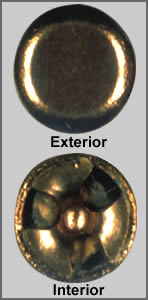Home | Glossary | Resources | Help | Contact Us | Course Map
Archival Notice
This is an archive page that is no longer being updated. It may contain outdated information and links may no longer function as originally intended.
Centerfire
Centerfire primers are more complex because of their internal components. These primers have three to four components depending on the brand. All have a primer cup, an anvil, and the priming chemicals or mix. In many types, foil paper is placed between the mix and the anvil to facilitate assembly.
Most metallic primer cups are made of cartridge brass; steel may also be used. Similar to cups for cartridge cases or bullet jackets, primer cups are produced on a cupping press.
After cupping, the parts are tumbled to remove sharp edges at the open end of the cups. This smoothes the cup, making insertion in cartridge cases easier. Most commercial primer cups are nickel-plated for corrosion resistance.
Anvils, the smallest of ammunition components, are made on a small blanking press. Sheets of brass are fed into a press fitted with multiple blanking punches. Dies set below the punches shape the anvil into the three-dimensional form.
At the explosive chemical facility, the hazardous priming mix is blended. As with rimfire priming, the mix is kept wet for safe handling. Cups and anvils are delivered to the chemical facility for assembly.
As with rimfire priming, wet mix is forced into holes in a charge plate to set the correct volume of mix for each primer. The wet pellets are ejected into primer cups. A compaction press forms the pellet to fill the entire bottom of the cup. At this point, foil paper may be placed on top of the pellet to prevent it from sticking to the compaction pins.
Next, anvils are added to the charged cups. Aligned in close-fitting plates, they are pressed into the cups, leaving part of the anvil exposed above the edge of the cup. To provide moisture resistance and to help hold the parts in alignment, a drop of nitrate sealant is added to the assembled primer.
Visual inspection is important for assuring the quality of centerfire primers. The anvil must not be tipped or inverted; the foil paper must not be out of position. Although electronic image inspection systems are improving, they have not advanced to the standard of the human eye. Wet primers are dried, completing the primer manufacturing process.
Testing
Similar to primed rimfire cases, the centerfire primers are tested for adherence to sensitivity specifications. Unlike rimfire cases, centerfire primers must first be inserted in a standard brass cartridge case and tested as specified in the manufacturers drop-testing protocol.
Shotshell
Primers for modern shotshells have an additional part; the battery cup supports and adds strength to the primer. Battery cups may be made of copper, brass, or copper-plated steel.
The shotshell anvil is larger than that of a rifle/handgun primer anvil. The anvil is a flat plate mounted perpendicular to the cup. Its leading edge rests against the inside of the battery cup.
Primer cups are charged and compacted similarly to metallic cartridge primers. However, different equipment is employed to press the cup into the large battery cup which, at this point, already contains the anvil.
The battery cup is hollow and holds a significant volume; it is important to prevent finely granulated propellants from entering the cup. If this happens, the added pressure inside the cup at firing can damage the bolt or breechface of a shotgun. Thus, the opening (flashhole) through which flame and gas will pass is sealed with a thin, combustible paper or plastic disk before seating the anvil.
After the primers pass dimensional and sensitivity tests, they are ready for loading.
Additional Online Courses
- What Every First Responding Officer Should Know About DNA Evidence
- Collecting DNA Evidence at Property Crime Scenes
- DNA – A Prosecutor’s Practice Notebook
- Crime Scene and DNA Basics
- Laboratory Safety Programs
- DNA Amplification
- Population Genetics and Statistics
- Non-STR DNA Markers: SNPs, Y-STRs, LCN and mtDNA
- Firearms Examiner Training
- Forensic DNA Education for Law Enforcement Decisionmakers
- What Every Investigator and Evidence Technician Should Know About DNA Evidence
- Principles of Forensic DNA for Officers of the Court
- Law 101: Legal Guide for the Forensic Expert
- Laboratory Orientation and Testing of Body Fluids and Tissues
- DNA Extraction and Quantitation
- STR Data Analysis and Interpretation
- Communication Skills, Report Writing, and Courtroom Testimony
- Español for Law Enforcement
- Amplified DNA Product Separation for Forensic Analysts



